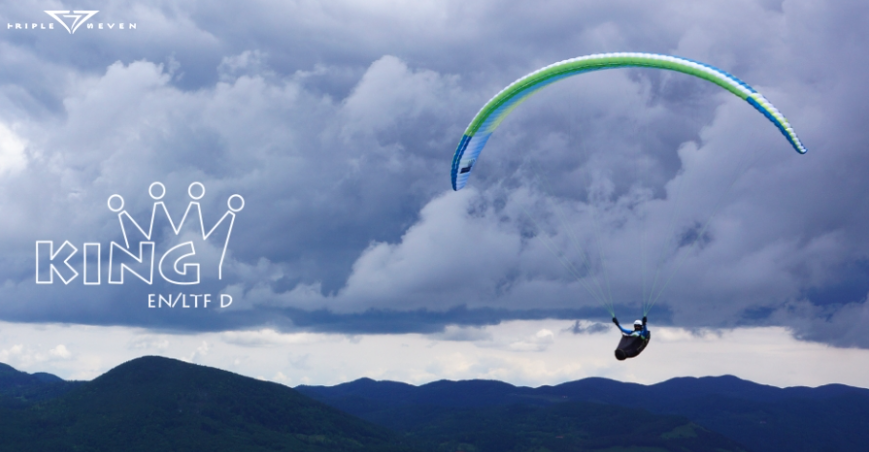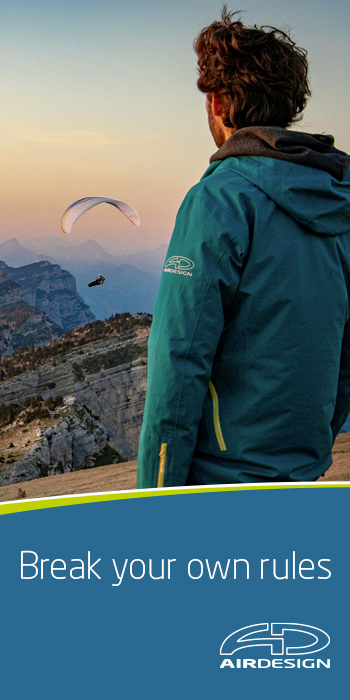
Ziad Bassil hails the Triple Seven KING
Ziad Bassil has been flying paragliders for over 20 years. He flies the mountains of his native Lebanon and provides the paragliding community with independent and unbiased glider reviews on the latest product releases. His opinions and comparisons can be found on his blog : Dust of the Universe.
Triple Seven KING EN-D S (75-95kg) and M (90-110kg)
Triple Seven gliders was founded by two PWC flying brothers, who had worked in the past with several manufacturers. Their reputation at the time was their fast flying ability in competition at the highest level.
Thereafter, Triple Seven was born and their first products appeared in the B and C category: the Rook 1 and the amazing Queen which still has the best glide at full speed in the EN-C category! Then came the Rook 2 which sits at the top in terms of best performers in the EN-B category and extremely accessibility.
These gliders designed by the Valic brothers, seem to be inherant to the high performance aim and each have relatively comfortable handling in their respective categories.
The King is here…
The King has a strong shark nose with a 3-line layout. The lower lines are thin but sheathed, the mid and upper ones are thin and unsheathed; the extremities plus the brake line geometry are very thin micro lines.
I have the S size (75-95) which I flew between 90 and 95 all-up, and the M size (90-110) at 107.5 all up.
The gliders I used for this EN-D category comparison are the Mantra 6 SM and ML, the Peak 4-21 and 23 , the Avax XC5-26, the IP6-23 .
Launching the King S and M in, 5 km/h to + 15 km/h, needs a steady pull to accompany the glider. It’s slightly slower than an M6 to reach overhead, but it’s surely very easy for an EN-D glider as it goes up in one solid shape !
Flying the King S with the same X-Rated 6 harness I used for all the mentioned gliders, flown at 93 all up, showed a moderate to agile glider which could be similar to the agility of the Mantra 6 SM flown at the same weight.
The brake travel is short to moderate, resembling the M6 SM brake travel .
The differences in thermal entry is that the King S pitches slightly back a little before entering.
The King M flown at 108 doesn’t have that pronounced pitch back movement and gives a neutral one instead.
The King could be described as a comfortable D glider when flown in moderate turbulence.
Flying the glider in some nasty ‘winter’ turbulent air, the King needs more active piloting than a Mantra 6 MS and slightly less piloting than the Peak 4 21 which I was test flying at the same time.
The glider’s movements in some leeside thermals are sharp with always with a pronounced backward pitch on the S rather than biting forwards. The M size showed me a more neutral pitch.
Of course sometimes it pulls you to the thermals, but in the relatively “moderately” turbulent conditions (only the summer conditions will give me a better idea) , I found it easy to control the forward pitch movement, and in some “spaghetti” air, I would have liked to have seen a more neutral pitch with the S size.
The climb rate performance for both the S and the M size in very weak thermals (0.3m/s) is moderate to good resembling the Peak 4.
Once the thermals are steady and homogenous the very good maneuverability of the King doesn’t loose any weak thermal cores, and the flat turning ability helps immensely to stay centred. It has much better climb than the Queen in small conditions, even when loaded.
In those very weak conditions the M6 could still have a slight edge in floatability…But i’m being a little picky…
Glide
Doing some glide comparisons with the M6, Peak 4, and IP6, showed on several occasions a superiority in glide power for the King S and more so for the M size !
For instance the M6, MS (80-95) at 93 compared to the King M (90-110) flown at 108, gave the King a full +2 km/h trim speed and a very impressive glide angle similar to that of a full CCC comp glider !
Flying the King S (75-95) at 93 all up next to a Peak 4-23 (85-105), gave me the same big visual advantage in glide for the King S and as we both used the speed bar, the differences were largely in my favor !
The top speed of the Peak 4-23 is still around +3 km/h more similarly loaded versus the King S size.
I found it that especially around 45- 47 km/h the King’s glide angle is remarkably better and
I was not expecting such a clearly visible glide difference. Usually there’s a small glide difference between newly tested gliders, but not on this occasion !
The King does indeed have an amazing glide…or should I say, the glide angle is worthy of a King !
The IP6-23, still has also more top speed (+ 6 km/h) , over the King S, followed by the M6 (+ 2 km/h) .
I measured the King S top speed at 1000 ASL with 93 all up around 56 km/h with overlapping pulleys.
The glide at that speed is very nice, but I felt that the best glide is around ± 46 km/h for the S size which many XC pilots use frequently.
I found that racing at that speed through moderate turbulent air is quite stable as I was able to maintain equal pressure on the accelerator.
Big ears are easy to induce with stable behavior and efficient descent rate at -3m/s with full bar. They open smoothly.
CONCLUSION:
The King is the new reference in gliding power in the EN-D category .
It seems that Triple Seven has built a performance and reasonably accessible, agile, gliding machine for “experienced” EN-D pilots.
Upgrading from the Queen is logical if it was already flown easily for two seasons in strong conditions.
I’m sure that any C or D pilot test flying the King, will marvel at this superb gliding Albatros.
In partnership with the Author, Rock the Outdoor has been authorised to modify the original text for reader appreciation.


